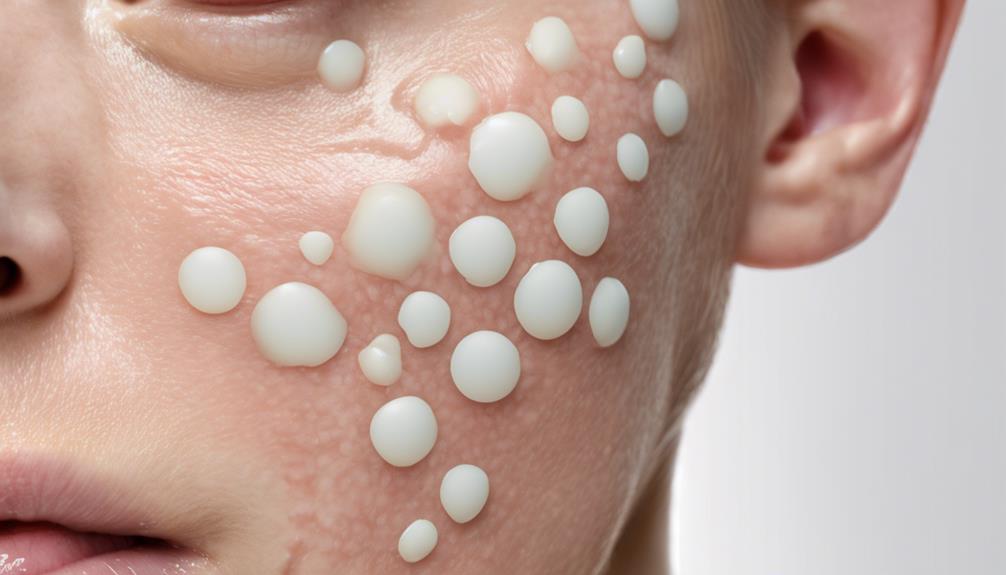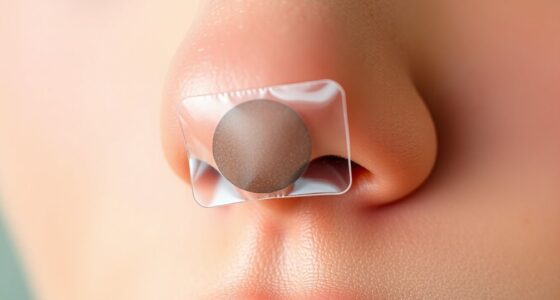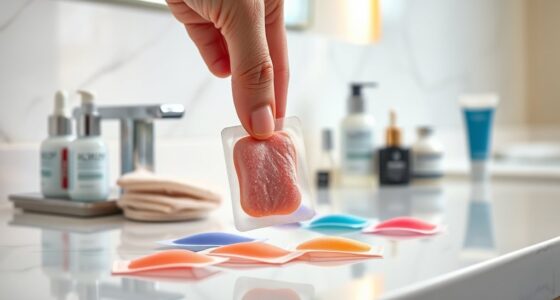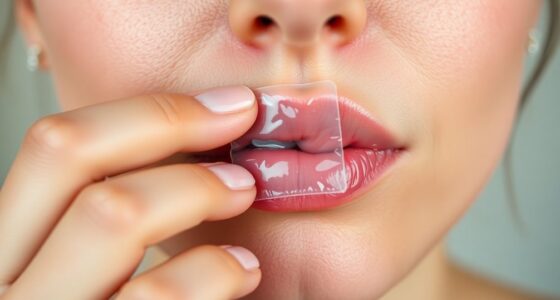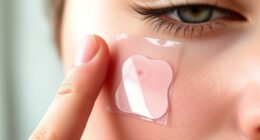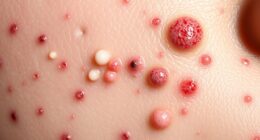Pimple patches create a protective barrier over your pimple, absorbing oil, pus, and dirt for faster recovery. Some patches contain ingredients such as salicylic acid or tea tree oil, which help regulate oil production, reduce inflammation, and promote a cleaner healing environment. The gel-like substance formed by the patches works to combat excess oil, trap bacteria, and expel pus more rapidly. By serving as a shield, they prevent infections, scarring, and provide a moist environment for healing. Their impermeable layer protects against bacteria and accelerates the healing process. Pimple patches are a simple yet effective way to aid your skin’s natural healing process.
Key Takeaways
- Forms protective barrier over pimple
- Absorbs excess oil, pus, and dirt
- Maintains moisture balance
- Prevents infection and scarring
- Speeds up healing process
Pimple Patch Mechanism

Pimple patches function by forming a protective barrier over the affected area, preventing bacterial intrusion and promoting faster healing. The hydrocolloid material in these patches works wonders by absorbing excess oil, pus, and dirt from the pimple, creating an ideal environment for recovery. Additionally, some patches are infused with salicylic acid or tea tree oil, targeting inflammation and bacteria effectively. This combination not only absorbs impurities but also helps in promoting quicker healing.
The gel-forming hydrocolloid maintains a moisture balance, aiding in the healing process. Moreover, these patches discourage the habit of touching or picking at the pimple, which can lead to scarring. By forming a protective shield, these patches keep bacteria out while actively working on the pimple, making them a reliable ally in the quest for clearer skin.
Absorption of Excess Oil

Pimple patches excel at absorbing excess oil, which is essential for combating pimple formation. The patches work by drawing out sebum and oils, creating a clean environment for the pimple to heal effectively.
Through this oil control mechanism, pimple patches help in reducing inflammation and promoting faster recovery.
Sebum Absorption Process
The hydrocolloid material in the patch efficiently draws out and absorbs excess sebum from the skin, aiding in reducing inflammation and promoting faster healing. This process not only helps in healing the pimple but also prevents further breakouts by keeping the pores clear. The absorption of sebum creates a drier environment around the pimple, which is essential for speeding up the healing process.
- Hydrocolloid Magic: This material acts like a sponge, soaking up the excess oil.
- Inflammation Soothing: By reducing inflammation, the patch helps calm down the angry redness.
- Healing Boost: The removal of excess oil promotes a quicker healing process, getting you back to clear skin faster.
Oil Control Mechanism
Efficiently drawing out excess oil, the hydrocolloid material in pimple patches aids in reducing inflammation and promoting faster healing. These hydrocolloid patches act like a sponge, absorbing the oil and sebum that contribute to pimple formation.
By controlling oil production, they create an environment that fosters quicker healing and prevents bacterial growth. This oil control mechanism not only helps flatten the pimple but also reduces the risk of scarring or post-inflammatory hyperpigmentation.
Pimple patches are effective at targeting and treating pimples due to their ability to absorb excess oil. By using these patches, you can actively manage oil levels on the skin, which plays an essential role in maintaining clear and healthy skin.
Excess Oil Removal
Absorbing excess oil through its hydrocolloid material, pimple patches work by reducing inflammation and preventing further breakouts.
- Pimple patches act like a sponge, drawing out excess oil and sebum.
- Creating a cleaner environment around the pimple helps promote faster healing.
- By absorbing oil, pimple patches aid in flattening the pimple and minimizing its appearance.
Bacteria and Pus Removal
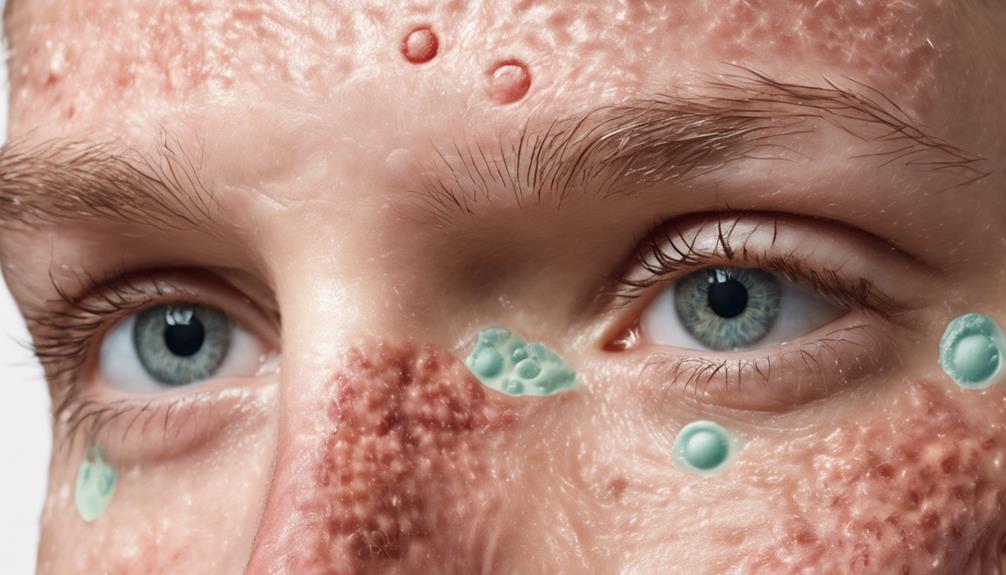
Using hydrocolloid material, pimple patches effectively draw out bacteria and pus from the affected area, promoting a clean environment for healing. These patches create a barrier that prevents external bacteria from causing further infection, while also reducing inflammation by absorbing excess fluids. As the patch works its magic, you might notice a visible white residue – a sign that it's successfully tackling the bacteria and pus, leaving your skin clearer and calmer.
To give you a clearer picture, here's a breakdown of how pimple patches help in bacteria and pus removal:
| Absorption | Barrier | Inflammation |
|---|---|---|
| Draws out bacteria and pus effectively | Acts as a shield against external bacteria | Reduces inflammation by absorbing excess fluids |
Pimple patches not only tackle the root of the problem by cleaning out the impurities but also aid in flattening the pimple and reducing redness. So, next time you spot a pesky pimple, trust these little heroes to work their magic!
Formation of Gel-like Substance

When a pimple patch comes into contact with a pimple, it forms a gel-like substance due to the hydrocolloid material it contains. This gel-like substance serves several important functions:
- Absorbs Excess Oil: The gel absorbs excess oil present in the pimple, helping to reduce inflammation and the shiny appearance often associated with pimples.
- Fights Bacteria: By trapping bacteria within the gel, it prevents further infection and promotes a cleaner environment for the pimple to heal.
- Removes Pus: The gel also helps to draw out pus from the pimple, aiding in the natural drainage process and speeding up the healing time.
This gel-like substance not only tackles the immediate issues of excess oil, bacteria, and pus but also creates a protective barrier over the pimple. This barrier shields the affected area from external contaminants, reducing the risk of further infection and allowing the skin to recover more efficiently.
Protective Barrier Function
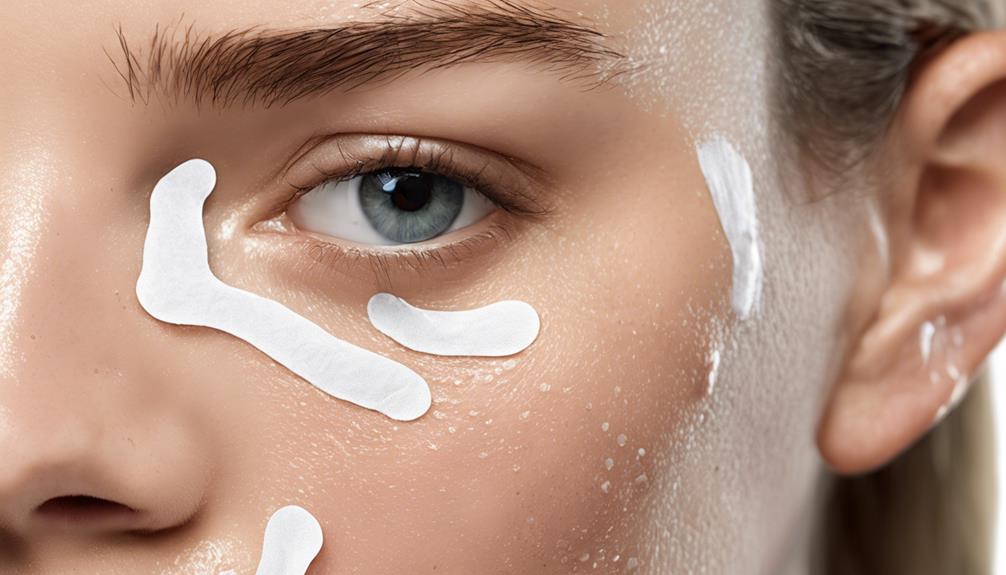
After forming a gel-like substance to address oil, bacteria, and pus in a pimple, pimple patches further function by creating a protective barrier over the affected area. This protective barrier serves as a shield, safeguarding the pimple from external bacteria and contaminants that could worsen the condition.
By preventing touching and picking, the patch reduces the risk of infection and potential scarring, allowing the pimple to heal undisturbed. The hydrocolloid material within the patch plays a pivotal role in this process by absorbing excess oil, pus, and fluids from the pimple, which in turn promotes faster healing.
The impermeable outer layer of the patch seals off the pimple, maintaining a clean and moist environment essential for effective healing. Through the creation of this effective healing environment, pimple patches support and expedite the skin's natural recovery process, aiding in the swift resolution of the blemish.
Prevention of Infection
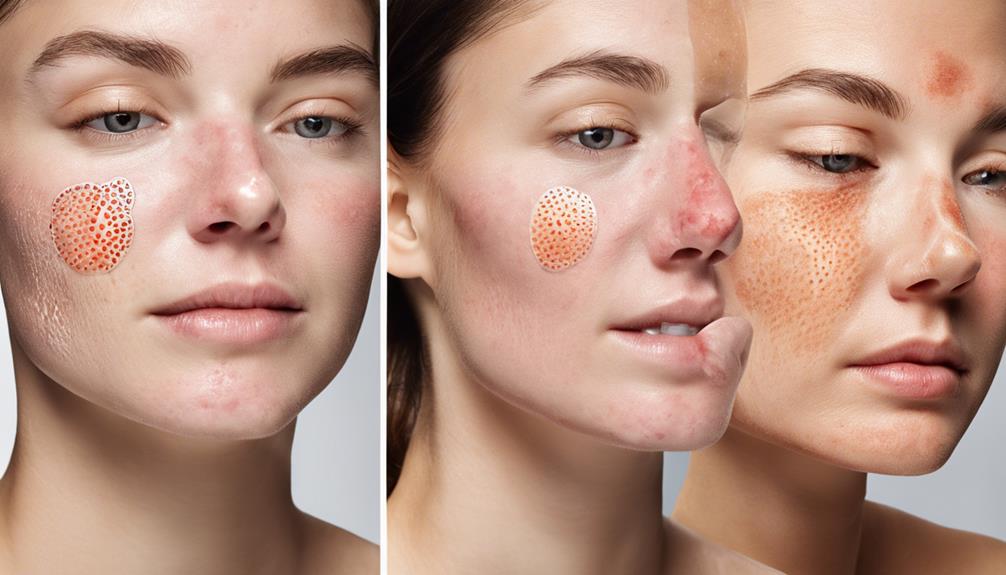
Pimple patches play an important role in preventing infection by forming a protective barrier that blocks harmful bacteria. This barrier shields the pimple, minimizing the risk of contamination and supporting the healing process.
Infection Risk Reduction
To enhance the healing process and prevent infection, pimple patches create a protective barrier that effectively seals the affected area from external bacteria. This vital outer layer plays an essential role in reducing the risk of infection and maintaining a clean environment for the pimple to heal.
By blocking out harmful bacteria, pimple patches aid in faster healing, minimizing the chances of further inflammation.
- Creates a barrier that prevents external bacteria from infecting the pimple.
- The impermeable outer layer of the patch seals the pimple, reducing the risk of infection.
- Helps maintain a clean and protected environment for the pimple to heal.
Bacteria Barrier Formation
By forming a protective barrier against bacteria, pimple patches effectively prevent infections and promote ideal healing conditions. The essential outer layer of the patch serves as a barrier against bacteria, sealing the pimple and keeping external contaminants out. This action prevents bacterial infiltration, creating a clean and controlled healing environment. Not only does this reduce the risk of spreading infection to surrounding skin areas, but it also allows the pimple to heal faster and more effectively. The vital function of the patch is crucial in maintaining a clean environment for the pimple to recover without interference. Let's take a closer look at how pimple patches create this bacteria barrier:
| Preventing Infection Risks | |||
|---|---|---|---|
| Impermeable Outer Layer | Clean Healing Environment | Prevent Bacterial Infiltration | Barrier Against Bacteria |
Wound Healing Promotion
Creating an effective barrier against harmful bacteria, pimple patches support the promotion of wound healing by preventing infections and maintaining a conducive environment for recovery. These patches help wound healing promotion by:
- Creating a protective barrier: Shielding the pimple from external contaminants, they reduce the risk of infection.
- Absorbing excess fluids: By drawing out oil and pus, they keep the area clean and promote faster healing.
- Reducing inflammation: Preventing bacteria from entering the wound helps minimize swelling and discomfort.
Pimple patches not only prevent infection but also aid in promoting faster healing by creating an ideal environment for the body's natural recovery processes.
Faster Healing Promotion
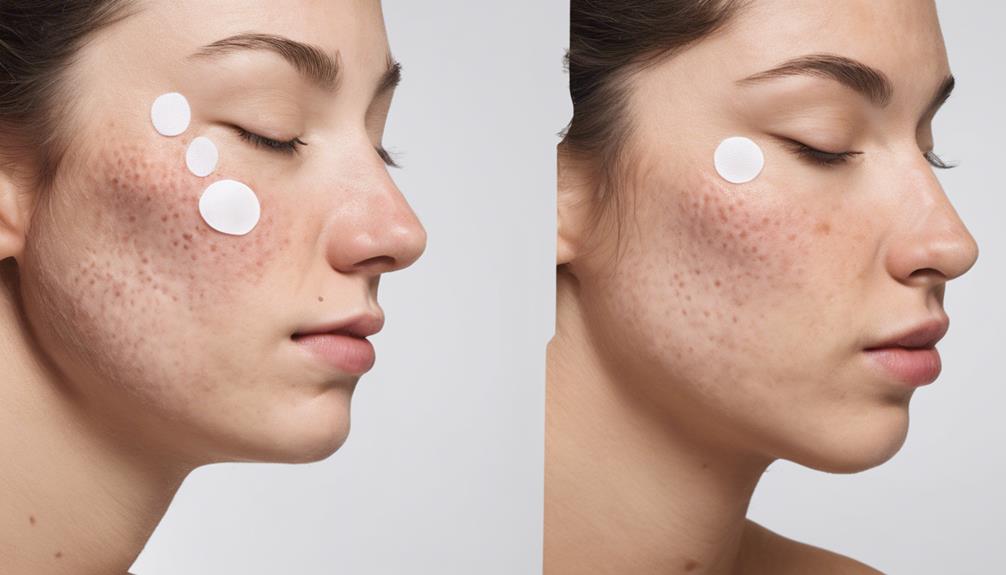
Pimple patches work by accelerating the healing process through the creation of a moist environment that aids in absorbing excess fluids and oils. The hydrocolloid material in acne patches helps guarantee impurities from clogging pores, promoting faster healing of the skin.
By keeping the affected area protected, these patches support the natural healing process and reduce the risk of scarring. They act as a barrier, shielding your skin from external factors like bacteria, allowing the pimple to heal undisturbed.
The adhesive nature of these patches guarantees continuous contact with your skin, maximizing their effectiveness in promoting faster healing. This method not only speeds up the recovery of popped zits but also helps maintain the skin's integrity during the healing phase.
Treatment for Popped Zits

Pimple patches are a great option for treating popped zits as they help in healing the affected area faster by keeping it clean and protected.
These patches also work to prevent the spread of infection, reducing the risk of scarring or worsening the condition.
Healing Popped Zits
After a zit has been popped, using a pimple patch can aid in the healing process by creating a protective barrier that promotes faster recovery. Patches with hydrocolloid technology draw out impurities, absorb excess fluid and pus, and reduce inflammation, helping the skin recover from the trauma of popping.
Applying a pimple patch on a popped zit can also prevent scabbing and scarring, leading to smoother healing. The hydrocolloid material in pimple patches works effectively to help popped zits heal faster than leaving them uncovered.
Preventing Infection Spread
To effectively prevent the spread of infection in popped zits, creating a barrier with pimple patches is vital. These patches help seal the skin, blocking external factors from causing further contamination and creating a clean healing environment.
By absorbing excess fluids, they aid in preventing the spread of infection and maintaining a protective barrier over the affected area. Pimple patches play an important role in containing and treating popped zits, which are vulnerable to bacterial invasion.
Proper use of these patches can help minimize scarring and speed up the healing process. By utilizing pimple patches, you can help prevent infection spread, promote a healing environment, and support your skin in its recovery journey.
Promoting Skin Recovery
Sealing the popped zit with a pimple patch provides a protective barrier that promotes skin recovery by creating a favorable healing environment. These patches absorb excess fluids, such as oil, bacteria, and pus, which helps expedite healing and minimize redness.
By preventing infections, they aid in creating an ideal healing environment for your skin. Additionally, using pimple patches can prevent further irritation and scarring from popped zits.
This simple step not only helps in the recovery process but also minimizes the temptation to pick at the affected area, ultimately leading to faster healing and clearer skin.
Prevention of Touching or Picking

Using a pimple patch helps prevent touching or picking at the affected area, reducing the chances of infection and scarring. These patches act as a physical barrier, discouraging the urge to touch or pick the pimple. The adhesive nature of pimple patches not only keeps them securely in place but also shields the treated area from external factors that could worsen the condition.
By creating a controlled environment, pimple patches help reduce the risk of infection by minimizing the spread of bacteria. This controlled environment also promotes faster healing by allowing the skin to repair itself effectively. Additionally, covering the pimple with a patch helps maintain its integrity and prevents subconscious picking behaviors that can further irritate the skin.
Enhanced Healing Environment
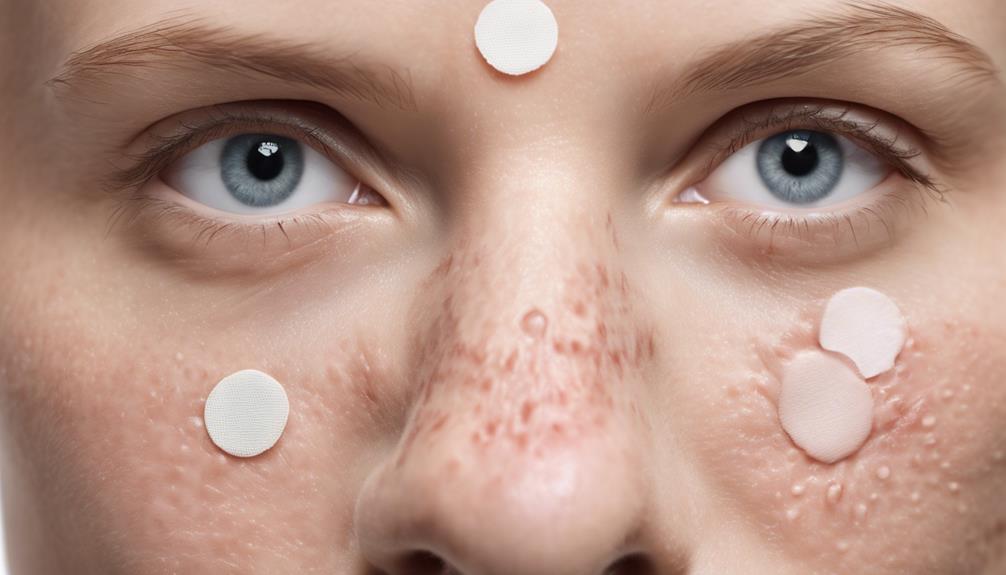
Creating an ideal healing environment, pimple patches effectively absorb excess oil, bacteria, and pus from the affected area. The hydrocolloid material in the patch transforms into a gel-like substance, promoting faster healing by keeping the area moist and aiding in the recovery process.
The protective outer layer of the patch acts as a barrier, sealing the pimple to prevent bacteria from entering and causing infection. Additionally, this layer helps in reducing the risk of scarring and further irritation by preventing touching or picking at the pimple.
- Hydrocolloid patch turns into gel for faster healing.
- Protective outer layer seals the pimple to prevent bacteria infection.
- Prevents touching or picking, reducing scarring.
Frequently Asked Questions
Do Pimple Patches Work on Unpopped Pimples?
Yes, pimple patches are effective on unpopped pimples. They create a protective barrier that absorbs excess oil, bacteria, and pus, promoting faster healing without active acne-fighting ingredients.
Hydrocolloid patches turn into a white gel spot as they absorb fluids from the pimple. These patches reduce redness, inflammation, and oiliness in unpopped pimples, preventing further irritation and promoting healing even for blackheads, whiteheads, or cystic acne.
Do Pimple Patches Really Work?
Pimple patches do work! They're effective at improving the appearance of pimples by creating a healing environment that speeds up recovery.
Hydrocolloid patches absorb fluids and promote faster healing, even for popped pimples.
Applying topical treatments under the patch can enhance treatment effectiveness, although some treatments may cause skin irritation.
Why Do Pimple Patches Turn White?
When a pimple patch turns white, it's showing that it's doing its job by pulling out gunk like oil, bacteria, and pus from your skin. The white color means the patch is absorbing impurities, creating a gel-like substance that turns it white.
This visual confirmation assures us that the patch is effectively drawing out excess fluids and helping the pimple heal. It's like a superhero cape for your skin, fighting off those pesky imperfections.
How Long Do Pimple Patches Take to Work?
Pimple patches typically start working in a few hours, showing visible improvements overnight. They work by absorbing excess oil, pus, and bacteria from the pimple.
The healing process varies based on individual skin and pimple severity. Consistent use can lead to faster healing and reduced inflammation.
Conclusion
To sum up, pimple patches work like tiny superheroes, absorbing excess oil, removing bacteria and pus, forming a protective barrier, and promoting faster healing. These innovative patches not only target individual breakouts but also help to minimize the appearance of redness and swelling around the affected area. By creating an optimal environment for the skin, they effectively reduce the likelihood of scarring. Understanding how pimple patches promote healing can empower individuals to tackle stubborn blemishes with confidence and clarity.
They create an ideal environment for zits to heal without interference, preventing further irritation.
So next time you have a pesky pimple, trust in the power of a pimple patch to save the day and help your skin look its best.
Emma founded Patchology.org with a vision to simplify skincare through the innovative use of patches. With over a decade of experience in skincare blogging, Emma ensures that every piece of content on the site meets the highest standards of clarity and integrity. She loves curating content that makes skincare accessible to everyone.

